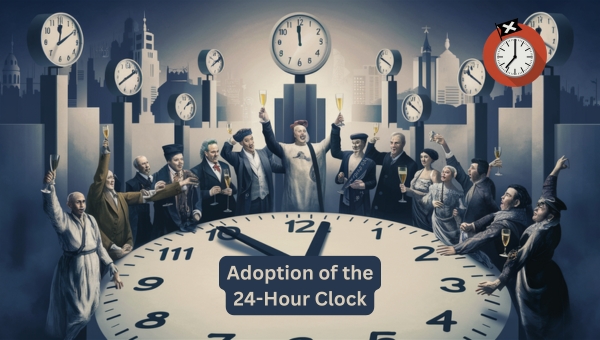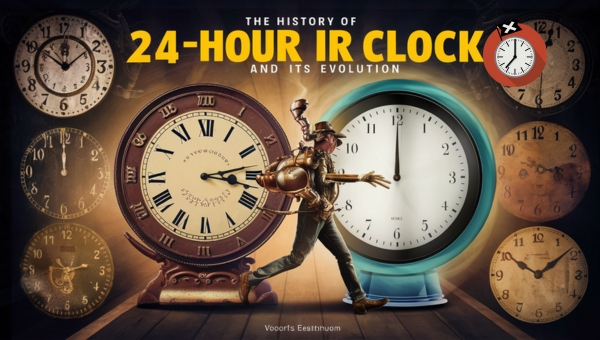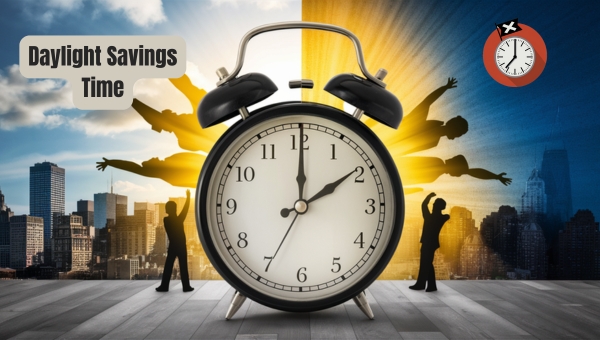History of the 24 Hour Clock – A Comprehensive Journey

The History of the 24-Hour Clock and how it transformed timekeeping? This article will take you on a captivating journey from ancient civilizations to modern-day usage. We’ll explore early methods like sundials, the creation of the 12-hour system, and the pivotal shift to the 24-hour format.
You’ll also learn about its adoption in military and civilian life, international standardization, and key milestones. By the end, you’ll understand the benefits of this system and its global impact. Let’s dive into the fascinating evolution of how we measure time!
The Origins of Timekeeping
Tracking time has always been a crucial aspect of human civilization. Understanding the history of how we measure time allows us to appreciate the systems we use today. Let’s dive into the origins of timekeeping, starting with early civilizations and their methods, followed by the development of the 12-hour system, and finally, the transition to the 24-hour clock.

Early Civilizations and Time
Ancient civilizations like the Egyptians and Babylonians were among the first to develop methods for tracking time. These early timekeepers relied heavily on natural elements to measure the passage of hours and days.
Here are some key points about their practices:
- Sundials: The Egyptians are credited with creating the earliest known sundials around 1500 BCE. These devices used the position of the sun’s shadow to indicate the time of day. The length and position of the shadow would change as the sun moved across the sky.
- Water Clocks: Also known as clepsydras, water clocks were used by both Egyptians and Babylonians. These devices measured time by the regulated flow of water from one container to another.
- Lunar Calendars: The Babylonians developed lunar calendars based on the cycles of the moon. This helped them plan agricultural activities and religious events.
- Star Clocks: Egyptians also used star clocks, which relied on the rising and setting of specific stars to divide the night into twelve parts.
These early methods laid the foundation for more sophisticated timekeeping systems that would follow.
The Development of the 12-Hour System
The creation of the 12-hour clock system marked a significant advancement in the way humans measured time. This system divided the day and night into two periods of twelve hours each.
Here are some important aspects of its development:
- Egyptian Influence: The Egyptians are also credited with developing the 12-hour division. They used a set of 12 stars to measure the time at night and divided the daytime into 12 equal parts.
- Greek and Roman Adoption: The Greeks and Romans adopted this system, integrating it into their daily lives. Roman sundials and water clocks were designed to reflect the 12-hour division.
- Mechanical Clocks: The invention of mechanical clocks in medieval Europe further solidified the 12-hour system. These clocks featured two sets of 12-hour intervals, which became the standard for centuries.
The 12-hour system was practical and easy to understand, but it had limitations that would eventually lead to the development of the 24-hour clock.
Transition to the 24-Hour System
The shift from the 12-hour system to the 24-hour clock was driven by the need for greater precision and clarity in timekeeping.
Here’s how this transition unfolded:
- Astronomical Observations: As astronomers made more precise observations of the skies, they required a timekeeping system that could account for every hour of the day. This led to the adoption of a 24-hour system in astronomical contexts.
- Military Use: The military found the 24-hour clock to be more effective for coordinating operations and reducing confusion. By eliminating the need to specify AM or PM, they could avoid potential misunderstandings.
- Global Standardization: Over time, the 24-hour clock gained acceptance in various fields, including transportation and communication. The need for a standardized timekeeping system in an increasingly interconnected world further propelled its adoption.
The transition to the 24-hour system was a significant step in the evolution of timekeeping, offering a more precise and universally understood method to track the hours of the day.
Adoption of the 24-Hour Clock
The transition from the 12-hour clock to the 24-hour clock wasn’t an overnight change. It was a gradual process influenced by various sectors and organizations. Let’s delve into how the 24-hour clock was adopted, starting with its significant use in the military and eventually making its way into civilian life and international standards.

Military Influence
Military organizations were among the first to recognize the need for a standard timekeeping system that minimized confusion.
The 24-hour clock became essential for several reasons:
- Precision in Communication: In military operations, precise timing is crucial. The 24-hour clock eliminates ambiguity, ensuring that orders and schedules are understood clearly.
- Global Coordination: Military forces often operate across different time zones. Using a 24-hour clock helps synchronize activities, reducing the risk of errors.
- Operational Efficiency: By adopting the 24-hour clock, military units could plan and execute missions with greater accuracy and efficiency.
The effectiveness of the 24-hour clock in military settings demonstrated its potential benefits, paving the way for wider adoption.
Introduction to Civilian Life
The utility of the 24-hour clock didn’t go unnoticed by civilian sectors. As industries grew more complex and interconnected, the need for a more precise timekeeping system became evident.
The 24-hour clock began to permeate various aspects of civilian life:
- Transportation: Railways, airlines, and shipping companies adopted the 24-hour clock to improve scheduling and reduce delays. This change ensured that timetables were easier to read and less prone to misinterpretation.
- Medicine: Hospitals and healthcare facilities started using the 24-hour clock to enhance patient care. By standardizing shift changes and medication schedules, medical staff could provide more consistent and reliable care.
- Public Services: Emergency services, broadcasting, and other public sectors found the 24-hour clock beneficial for maintaining round-the-clock operations.
The move to a 24-hour clock in these areas helped streamline operations and improve overall efficiency.
International Standardization
The 24-hour clock eventually became a recognized international standard, thanks to efforts by global organizations.
Key developments include:
- ISO Standards: The International Organization for Standardization (ISO) played a pivotal role in promoting the 24-hour clock. ISO 8601, an international standard for date and time representation, specifies the use of the 24-hour clock.
- United Nations: The UN and other international bodies adopted the 24-hour clock for official documents and communications. This adoption helped facilitate better coordination and understanding across different countries and cultures.
- Global Adoption: As more countries and organizations embraced the 24-hour clock, it became the norm in many parts of the world. Today, the 24-hour clock is widely used in various sectors, including aviation, technology, and finance.
The shift to the 24-hour clock has significantly improved global communication and coordination, making it an indispensable part of modern life.
The History of the 24-Hour Clock and Its Evolution
The journey of the 24-hour clock is a fascinating tale of innovation and necessity. Understanding its evolution provides insights into how societies have progressed in terms of timekeeping.

This section dives into the significant milestones and the widespread adoption of the 24-hour clock, shedding light on its current applications across various industries.
Key Milestones in the Evolution
The development of the 24-hour clock system has several key milestones worth noting:
- Ancient Egypt: One of the earliest known uses of a 24-hour system was by the Egyptians. They divided the day into two 12-hour periods using sundials and water clocks.
- Greek Influence: Greek astronomers and mathematicians further refined the concept, contributing to the broader adoption of the 24-hour system.
- Medieval Europe: Monasteries in medieval Europe adopted the 24-hour clock for more precise timekeeping in their daily rituals.
- Modern Standardization: The 19th and 20th centuries saw the formalization of the 24-hour clock, especially with the advent of the railways and telegraphy, which required standardized time to avoid confusion.
Global Adoption of the 24-Hour Clock
The spread of the 24-hour clock system is a testament to its utility and precision. Different regions adopted this system for various reasons:
- Europe: The need for a more accurate timekeeping method for industrial and transportation purposes led to the widespread adoption of the 24-hour clock in Europe.
- United States: Initially resistant, the U.S. slowly embraced the 24-hour clock, particularly in military and transportation sectors.
- Asia: Countries like Japan and China adopted the 24-hour clock during periods of modernization and industrialization.
- International Bodies: Organizations such as the International Organization for Standardization (ISO) and the United Nations have promoted the 24-hour clock as a global standard, further solidifying its usage worldwide.
Today, the 24-hour clock is commonly used in various countries, with digital interfaces and devices predominantly displaying time in this format. It aids in avoiding confusion, especially in international communications and travel.
Modern Usage of the 24-Hour Clock
In contemporary times, the 24-hour clock finds its application in numerous industries, enhancing clarity and precision:
- Aviation: Airlines and airports extensively use the 24-hour clock to prevent misunderstandings in flight schedules and operations.
- Medicine: Hospitals and medical facilities rely on the 24-hour clock to manage patient care schedules, medication timings, and shift changes.
- Technology: Digital devices, including computers, smartphones, and smartwatches, often default to the 24-hour format for its unambiguous nature.
- Military: The military continues to use the 24-hour clock for its precision and the elimination of any potential confusion.
The 24-hour clock has not only become a global standard but also an integral part of various critical sectors, demonstrating its enduring relevance and practicality.
Benefits of the 24-Hour Clock System
The 24-hour clock system offers numerous advantages, making it a preferred choice in various domains. From eliminating confusion to enhancing efficiency and even impacting cultural practices, this system has proven its worth. Let’s delve into these benefits individually.
Elimination of Ambiguity
One of the primary benefits of the 24-hour clock system is its ability to eliminate ambiguity. Unlike the 12-hour format, which repeats numbers and requires additional context (AM/PM), the 24-hour clock provides a unique identifier for each hour of the day.
This reduces the risk of errors in communication, especially in global contexts where time zones vary. For example:
- Clear Scheduling: When scheduling meetings across different time zones, using the 24-hour format ensures that there is no confusion about whether an event is in the morning or evening.
- Precise Communication: In emergencies, such as in aviation or healthcare, where every minute counts, the 24-hour clock helps avoid misunderstandings.
Enhanced Efficiency
The 24-hour clock system also enhances efficiency, particularly in industries that operate continuously. By simplifying scheduling and reducing the need for clarifications, operations can proceed more smoothly.
Consider these points:
- Shift Management: In factories or hospitals where shifts change throughout the day, the 24-hour clock helps managers keep track of staff schedules without ambiguity.
- Public Transportation: Timetables for trains, buses, and flights often use the 24-hour format to ensure passengers understand departure and arrival times clearly, leading to better punctuality and reduced delays.
Cultural and Practical Impact
The 24-hour clock system influences not just practical aspects of life but also cultural practices in various regions. Its adoption reflects and shapes the way societies organize and perceive time.
Here are some noteworthy aspects:
- Global Standard: Many countries and international organizations use the 24-hour clock as a standard, promoting consistency in global communication.
- Daily Life: In countries where the 24-hour system is prevalent, people grow accustomed to thinking about time in this format, which can influence how they plan their day.
- Cultural Significance: The use of the 24-hour clock can also signify modernity and efficiency, aligning with cultural values that prioritize precision and time management.
The 24-hour clock system is more than just a way of telling time. It is a tool that brings clarity, boosts efficiency, and even shapes cultural norms. By understanding its benefits, we can better appreciate why it remains a vital part of our daily lives.
Conclusion
The history of the 24-hour clock is a testament to human ingenuity and the quest for precision in timekeeping. From its origins in ancient civilizations to its adoption by military and civilian sectors, the 24-hour clock has revolutionized how we track and understand time.
Its global standardization has ensured consistent and clear communication across different industries and cultures. The benefits, including the elimination of ambiguity and enhanced efficiency, highlight its importance in our daily lives. If you found this deep dive into the history of the 24-hour clock enlightening, be sure to explore more insightful articles on our site!





